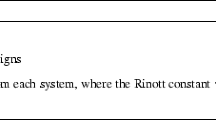Abstract
The introduction of uncertainty to mathematical programs greatly increases the size of the resulting optimization problems. Specialized methods that exploit program structures and advances in computer technology promise to overcome the computational complexity of certain classes of stochastic programs. In this paper we examine the progressive hedging algorithm for solving multi-scenario generalized networks. We present computational results demonstrating the effect of various internal tactics on the algorithm's performance. Comparisons with alternative solution methods are provided.
Similar content being viewed by others
References
D.P. Ahlfeld, R.S. Dembo, J.M. Mulvey and S.A. Zenios, Nonlinear programming on generalized networks. ACM Trans. Math. Software 13 (1987) 350.
D.P. Bertsekas,Constrained Optimization and Lagrange Multiplier Methods (Academic Press, New York, 1982).
D.P. Bertsekas and J.N. Tsitsiklis,Parallel and Distributed Computation: Numerical Methods (Prentice-Hall, Englewood Cliffs, NJ, 1989).
J.R. Birge, Decomposition and partitioning methods for multistage stochastic linear programs, Oper. Res. 33 (1985) 989.
J.R. Birge and S.W. Wallace, Refining bounds for stochastic linear programs with linearly transformed independent random variables, Oper. Res. Lett. 5 (1986) 73.
J.R. Birge and R.J.-B. Wets, Designing approximation schemes for stochastic optimization problems, in particular for stochastic programs with recourse, Math. Progr. Study 27 (1986) 54.
T.J. Carpenter, I.J. Lustig, J.M. Mulvey and D.F. Shanno, A primal-dual interior point method for convex separable nonlinear programs, Report SOR-90-2, Dept. of Civil Engineering and Operations Research, Princeton University (Apr. 1990).
G.B. Dantzig and P.W. Glynn, Parallel processors for planning under uncertainty, in:Supercomputers and Large-Scale Optimization, ed. J.B. Rosen, Ann. Oper. Res. 22 (1990).
R.S. Dembo, J.M. Mulvey and S.A. Zenios, Large scale nonlinear network models and their application, Oper. Res. 37 (1989) 353.
M.A.H. Dempster (ed.),Stochastic Programming (Academic Press, New York, 1980).
E. Edwards, Documentation for the ADO/SDS collection of stochastic programming codes, Working Paper WP-85-02, IIASA, Laxenburg, Austria (1985).
Y. Ermoliev and R.J.-B. Wets (eds.),Numerical Techniques for Stochastic Optimization (Springer, Berlin, 1988).
H.I. Gassmann, Optimal harvest of a forest in the presence of uncertainty, Working Paper WP-59, School of Business Administration, Dalhousie University (May 1987).
P.E. Gill, W. Murray and M.H. Wright,Practical Optimization (Academic Press, London, 1981).
M.I. Kusy and W.T. Ziemba, A bank asset and liability management model, Oper. Res. 34 (1986) 356.
I.J. Lustig, J.M. Mulvey and T. Carpenter, Formulating two-stage stochastic programs for interior point methods, Report SOR-89-16, Dept. of Civil Engineering and Operations Research, Princeton University (Sept. 1989), Oper. Res., to appear.
I.J. Lustig, R. Marsten and D.F. Shanno, Computational experience with a primal-dual interior point method for linear programming, Report SOR-89-17, Dept. of Civil Engineering and Operations Research, Princeton University (Oct. 1989).
J.M. Mulvey and H.P. Crowder, Cluster analysis: An application of Lagrangian relaxation, Manag. Sci. 25 (1979) 329.
J.M. Mulvey and S.A. Zenios, GENOS 1.0 user's guide: A generalized network optimization system, Working paper 87-12-03, Dept. of Decision Sciences, The Wharton School, University of Pennsylvania (Dec. 1987).
J.M. Mulvey and H. Vladimirou, Stochastic network optimization models for investment planning, in:Network Optimization and Applications, ed. B. Shetty, Ann. Oper. Res. 20 (1989) p. 187.
J.M. Mulvey and H. Vladimirou, Evaluation of a parallel hedging algorithm for stochastic network programming, in:Impacts of Recent Computer Advances on Operations Research, eds. R. Sharda, B.L. Golden, E. Wasil, O. Balci and W. Stewart (North-Holland, 1989) p. 106.
J.M. Mulvey and H. Vladimirou, Solving multistage stochastic networks: An application of scenario aggregation, Report SOR-88-1, Dept. of Civil Engineering and Operations Research, Princeton University (July 1989), Networks, to appear.
J.M. Mulvey and H. Vladimirou, Documentation for multistage stochastic generalized network optimization codes, Report SOR-89-15, Dept. of Civil Engineering and Operations Research, Princeton University (July 1989).
J.M. Mulvey and H. Vladimirou, Stochastic network programming for financial planning problems Report SOR-89-7, Dept. of Civil Engineering and Operations Research, Princeton University (April 1990).
J.M. Mulvey and H. Vladimirou, Parallel and distributed computing for stochastic network programming, Report SOR-90-11, Dept. of Civil Engineering and Operations Research, Princeton University (1990).
B.A. Murtagh and M.A. Saunders, MINOS 5.1 user's guide, Report SOL-83-20R, Systems Optimization Laboratory, Standford University (1987).
R.T. Rockafellar and R.J.-B. Wets, Scenarios and policy aggregation in optimization under uncertainty, Working Paper WP-87-119, IIASA, Laxenburg, Austria (Dec. 1987), Math. Oper. Res., to appear.
A. Ruszczyński, Regularized decomposition and augmented Lagrangian decomposition for angular linear programming problems, in:Theory, Software and Testing Examples in Decision Support Systems, eds. A. Lewandowski and A. Wierzbicki (Springer, Berlin, 1988) p. 71.
P. Tseng and D.P. Bertsekas, Relaxation methods for problems with strictly convex separable costs and linear constraints, Math. Prog. 38 (1987) 303.
R. Van Slyke and R.J.-B. Wets, L-shaped linear programs with applications to optimal control and stochastic programming, SIAM J. Appl. Math. 17 (1969) 638.
P. Varaiya and R.J.-B. Wets, Stochastic dynamic optimization approaches and computation, Working Paper WP-88-87, IIASA, Laxenburg, Austria (Sept. 1988).
S.W. Wallace, Solving stochastic programs with network recourse, Networks 16 (1986) 295.
R.J.-B. Wets, Stochastic programming: Solution techniques and approximation schemes, in:Mathematical Programming: The State of the Art, eds. A. Bachem, M. Grötschel and B. Korte (Springer, Berlin, 1982) p. 566.
R.J.-B. Wets, Solving stochastic programs with simple recourse, Stochastics 10 (1983) 219.
R.J.-B. Wets, Large-scale linear programming techniques in stochastic programming, Working Paper WP-84-90, IIASA, Laxenburg, Austria (1984).
R.J.-B. Wets, The aggregation principle in scenario analysis and stochastic optimization, in:Algorithms and Model Formulations in Mathematical Programming, ed. S.W. Wallace (Springer, Berlin, 1989) p. 91.
S.A. Zenios and R.A. Lasken, Nonlinear network optimization on a massively parallel Connection machine, in:Parallel Optimization on Novel Computer Architectures, eds. R.R. Meyer and S.A. Zenios, Ann. Oper. Res. 14 (1988).
H. Vladimirou, Stochastic networks: solution methods and applications in financial planning, PhD thesis. Dept. of Civil Engineering and Operations Research, Princeton University (1990).
Author information
Authors and Affiliations
Additional information
Research supported in part by grants from the National Science Foundation (DCR-861-4057) and the Mathematical and Analytics Computation Center of IBM Corporation, New York.
Rights and permissions
About this article
Cite this article
Mulvey, J.M., Vladimirou, H. Applying the progressive hedging algorithm to stochastic generalized networks. Ann Oper Res 31, 399–424 (1991). https://doi.org/10.1007/BF02204860
Issue Date:
DOI: https://doi.org/10.1007/BF02204860




